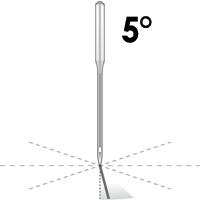Proper needle orientation is essential to producing a proper stitch. If the needle orientation is incorrect, the loop of thread that is created while making a stitch may not be in the appropriate location to be caught by the rotary hook to complete the stitch.
A damaged needle can also cause thread breaks.
Look for the following items when diagnosing a thread break.
Needle Angle Out of Range

Ideally, the eye of the needle should be 5° to the right of center when sewing. There is an acceptable range of 0°-20° to the right, but 5° is the absolute ideal. The chance of thread breaks increases if the needle orientation is outside of the acceptable range.
As a visual reference, think of a minute on a clock face as being 6°.
Adjust the needle orientation to have the eye of the needle 5° to the right. For more help, see the needle replacement section.
Needle in Backwards

Embroidery needles have a front and a back side. If you install the needle in backwards, you will most likely encounter thread breaks within the first few stitches after starting a design.
The front of the needle has a long groove (thread guide), while the back has an indented notch (scarf) just above the eye of the needle.
Reorient the needle to have the thread guide to the front, the scarf to the back, and the eye of the needle to be 5° to the right. For more help, see the needle replacement section.
Damaged Needle
Standard needles last approximately 4 to 6 solid sewing hours. After this time they begin to wear out. Burs may form on the needle or they become dull and cause thread breaks.
Replace the needle. For more help, see the needle replacement section.